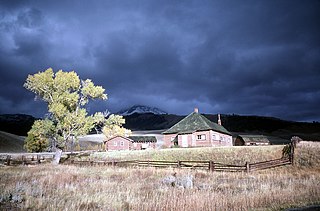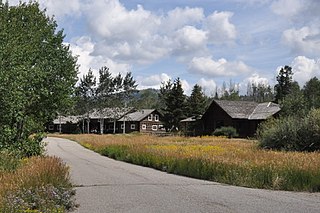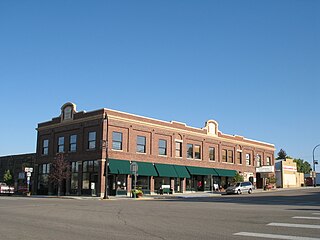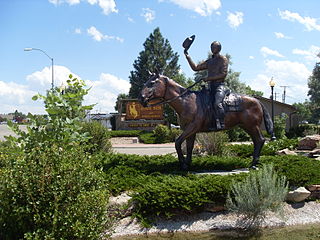
The Jim Gatchell Memorial Museum is an American West museum in Buffalo, Wyoming, housed in a 1909 Carnegie Library building.

The Lamar Buffalo Ranch is an historic livestock ranch in the Lamar River valley of Yellowstone National Park, in the U.S. state of Wyoming. It was created to preserve one of the last free-roaming American bison (buffalo) herds in the United States. The ranch was established in 1907 when 28 bison were moved from Fort Yellowstone to the Lamar Valley in the northeast corner of the park.

The Moose Entrance Kiosk was built between 1934 and 1939 by either the Public Works Administration or the Civilian Conservation Corps at the entrance to Grand Teton National Park. The log kiosk was built to National Park Service standard plans in the National Park Service Rustic style. It was originally located near the park's former administrative area, but was moved in the early 1960s to the new administration center and entrance at Moose. It is the last survivor of that building type and era in the park.

The Church of St. Hubert the Hunter and its associated library, also known as the Bondurant Protestant Episcopal Church were built in Bondurant, Wyoming, the church in 1940-41 and the library in 1943. The church was financed by the sale of a diamond bequeathed to the Episcopal Church by Mrs. John Markoe, which was to be sold to finance a memorial church. According to some versions, the church was to be built in the most remote part of the United States. Wyoming Bishop Winfred H. Zeigler suggested Bondurant, where he had been forced to take shelter from a blizzard while traveling in 1937. The diamond was sold for $1400, and Zeigler returned to Bondurant to organize the construction of the church by local volunteers.

The Ramshorn Dude Ranch Lodge in Grand Teton National Park was built after 1935 by mountaineers Paul Petzoldt, founder of the National Outdoor Leadership School, and Gustav Koven. The property that became the Ramshorn Ranch was originally established by Ransom Adams at the mouth of Gros Ventre Canyon near Ditch Creek. By 1921 the property was acquired by Jack and Dollye Woodsman, who established the Flying V dude ranch, featuring a large central lodge. In 1932 the lodge burned, prompting the Woodsmans to sell the ranch to Koven and Petzoldt in 1935, who planned to expand the dude ranch as a climbing school and hunting camp. Petzoldt withdrew from the partnership in 1937 after suggesting the name be changed to the Ramshorn Ranch. The present lodge was completed in 1937 by the Woodward brothers, who took over operation. A variety of owners and partners ensued until 1956, when the ranch was sold to the National Park Service. The Park Service then leased the ranch back to concessioners who operated it as the Elbo Ranch until 1973, replacing the former Elbo Ranch purchased by the Park Service. The Teton Science School was established on the property in 1974 under a special use permit.

The Hunter Hereford Ranch was first homesteaded in 1909 by James Williams in the eastern portion of Jackson Hole, in what would become Grand Teton National Park. By the 1940s it was developed as a hobby ranch by William and Eileen Hunter and their foreman John Anderson. With its rustic log buildings it was used as the shooting location for the movie The Wild Country, while one structure with a stone fireplace was used in the 1963 movie Spencer's Mountain. The ranch is located on the extreme eastern edge of Jackson Hole under Shadow Mountain. It is unusual in having some areas of sagebrush-free pasture.

The TA Ranch was the site of the principal events of the Johnson County Range War in 1892. The TA was established in 1882 as one of the first ranches in Johnson County, Wyoming. The TA is the only intact site associated with the range war, with trenches used by both sides still visible and scars on the nearby buildings. The ranch also documents the expansion and development of cattle ranching in Wyoming.

The Buffalo Main Post Office in Buffalo, Wyoming was built in 1911 as part of a facilities improvement program by the United States Post Office Department. The post office in Buffalo was nominated to the National Register of Historic Places as part of a thematic study comprising twelve Wyoming post offices built to standardized USPO plans in the early twentieth century.

The T E Ranch Headquarters, near Cody, Wyoming, is a log ranch house that belonged to buffalo hunter and entertainer Buffalo Bill Cody (1846–1917). The house may have originally been built by homesteader Bob Burns prior to 1895, when Cody acquired the ranch. Cody expanded the ranch to about eight thousand acres (32 km²), using the T E brand for his thousand head of cattle.

The Elephant Head Lodge is a guest lodge on the road to, and only 12 miles from, the east entrance of Yellowstone National Park, in Shoshone National Forest. The ranch includes two main lodges surrounded by support buildings and guest cabins. Beginning in 1926, the Elephant Head was developed by Buffalo Bill Cody's niece, Josephine Thurston and her husband Harry W. Thurston. The lodge was named after a distinctive rock formation that rises above the property.

This is a list of the National Register of Historic Places listings in Converse County, Wyoming.

The Buffalo Bill Boyhood Home was built by Isaac Cody, the father of Buffalo Bill Cody in 1841 at LeClaire, Iowa. The house was purchased as a tourist attraction by the Chicago, Burlington and Quincy Railroad and was moved to Cody, Wyoming, Buffalo Bill's adopted hometown, in 1933.

The Stock Center in Cody, Wyoming was built in 1927 as the original home of the Buffalo Bill Museum, serving in that purpose until the museum was relocated to a new complex across the street. The log structure is intended to suggest a stockman's log cabin, rendered on a large scale.

Mummy Cave is a rock shelter and archeological site in Park County, Wyoming, United States, near the eastern entrance to Yellowstone National Park. The site is adjacent to the concurrent U.S. Routes 14/16/20, on the left bank of the North Fork of the Shoshone River at an altitude of 6,310 feet (1,920 m) in Shoshone National Forest.

The Vore Buffalo Jump is an archeological site in Crook County, Wyoming. A sinkhole, formed where gypsum soil was eroded, leaving a steep-sided pit about 40 feet (12 m) deep and 200 feet (61 m) in diameter. Native American hunters could stampede bison in the direction of the pit, which was deep enough to kill or disable the animals that were driven into it. The location is one of a number of buffalo jump sites in the north central United States and southern Canada. The Vore site was used as a kill site and butchering site from about 1500 AD to about 1800 AD. Archeological investigations in the 1970s uncovered bones and projectile points to a depth of 15 feet (4.6 m). About ten tons of bones were removed from the site. About five percent of the site has been excavated, and the pit is estimated to contain the remains of 20,000 buffalo.
The Wardell Buffalo Trap in Sublette County, Wyoming is a small box canyon used by Native Americans for 500 years during the Late Prehistoric Period. Nearly 55 feet (17 m) of bison bones were found at the site. A campsite and butchering area is located nearby, and evidence has been found for a fence at the entrance to the canyon.

The HF Bar Ranch is located in Johnson County, Wyoming about 20 miles (32 km) northwest of Buffalo, Wyoming in the foothills of the Bighorn Mountains near Saddlestring, Wyoming. The ranch is a working cattle ranch comprising about 36 buildings, built between 1898 and 1921. The ranch is associated with Wyoming state senator and U.S. Congressman Frank O. Horton, who purchased it in 1911 with financial help from his investment banker brother-in-law and sister-in-law, Warren and Demia Gorrell. The Gorrells and their children spent summers in Wyoming, while the Hortons stayed year-round.

The Downtown Rawlins Historic District comprises the historic center of Rawlins, Wyoming. It comprises the area between Second and Sixth Streets and Front to Buffalo Streets and along 5th Street between West Spruce and West Cedar. The town owes much of its living to the Union Pacific Railway, which took advantage of spring in the Rawlins area to establish services there.

Commerce Block is a commercial building in Glenrock, Wyoming, built in 1917 during the Wyoming oil boom of the early 20th century. The nearby Big Muddy oil field brought prosperity to Glenrock, stimulating the growth of the town's commercial district. The building was built for the Glenrock Investment Company, a consortium of local investors, by Edward R. Reavill. The building housed the Glenrock State Bank until 1934. Other businesses in the building included a bar, a billiard parlor and a drug store. The Empress Theater took a two-story space in the east wing of the block. By the late 1920s the oil boom had ended and the theater passed through several owners, closing intermittently. In 1939 it was renamed the Wyoma Theater and had a prominent marquee.



















